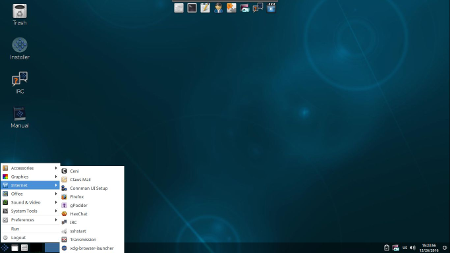
Siduction
Siducion è una distribuzione Linux basata su Debian “unstable” orientata al desktop e che offre ben 4 differenti Desktop Manger: KDE, LXDE, XFCE, Razon-qt. In particolare è nata come fork di Aptosid per facilitare l’installazione ed è sempre una rolling release.
Versione 21.2.0
Questa versione contiene:
The siduction team is very proud that for our 10th birthday (yes, we started out in July 2011) we can present to you siduction 2021.2.0. This one is dubbed »Farewell« in remembrance of our friend Axel, who passed away way to early. So no, farewell does not mean we are going anywhere. The highlight of this release is the resuscitated siduction manual, that goes back to the days of sidux, which some of you will remember as a former incarnation of siduction. We will go on a little history tour on that further down. But first things first: User/Password for the live session is siducer/live.
What’s new this time around?
The flavours we offer for siduction 2021.2 are KDE Plasma 5.20.5, LXQt 0.16.0-1, Cinnamon 4.8.6.2, Xfce 4.16, Lxde 11, and the images Xorg and noX, where Xorg comes with Fluxbox and noX has no X at all. GNOME and MATE did again not make it due to a lack of a maintainer within siduction. They might be back at some point or not. Of course, they are still installable from the repository.
As you can tell, due to the freeze in regard to desktops not much has changed since our last release. The released images are a snapshot of Debian unstable, that also goes by the name of Sid, from 2021-07-28. They are enhanced with some useful packages and scripts, an installer based on Calamares and a custom patched version of the Linux kernel 5.13.6, while systemd is at 247.3-6.
Plasma at the helm
Plasma is still our main offering, and it has made remarkable progress over the past year. We have it staffed with the latest additions that will hit with Plasma 5.21 in a couple of weeks, like the new system monitor that will be the successor to ksysguard and the Conference Companion Kongress. Also, years in the making, finally there is kio-fuse.
The latter allows you to mount remote directories into the root hierarchy of your local file system, thereby exposing KDE’s access capabilities like SSH, SAMBA/Windows, FTP, TAR/GZip/BZip2, WebDav and others to POSIX-compliant applications such as Firefox, OpenOffice, GNOME apps, shell utilities and more. Quite the handy tool.
As a special birthday treat, we have a 2nd image with Plasma on offer, that is based on the builds by Norbert Preining, featuring the latest and greatest Plasma 5.22.4. Norbert is the gentleman who also, together with the team of Debian-KDE-QT made sure that the soon-to-be released Debian 11 »Bullseye« will ship with Plasma 5.20, so you know you can trust their packages.
This image uses Intels iNet Wireless Daemon (iwd) for Wi-Fi and ships doas as a substitute for sudo with a much smaller footprint and a human-readable config file that can be as small as just one line. You will find a description on how to set up iwd for Wi-Fi further down. To get started with doas, you can take a look at this blog post, which gets you started. For a more thorough introduction, you may want to look at this article. There you also find a workaround for the missing bash-completion for Debian, which was the only pain point with doas.
siduction Manual
We are immensely proud that for our birthday we can offer an up-to-date version of the siduction manual. It took countless hours to get it into shape and into a current state. While with this release the manual is in German only, we strive to finish the English version for our next release. Our Non-German spoken users can for now use the services of a translator like deepl, which does an impressive job with technical translations.
A bit of nostalgia
Want to go on a nostalgic trip? Does someone remember sidux? That’s where the then so called bluewater-manual started in 2006. Back then we started by taking topics from the sidux-faq and reorganizing them into a manual. Then Trevor Walkley, an Australian gentleman, who went by the nickname of bluewater to match his fondness for sailing, took the rudder and turned the manual into a great knowledge base and led a translation team that translated large parts into something like a dozen languages.
The manual had one problem, and that was that it was built from static HTML pages. If there was no need to ever change anything, that would have been fine, but that is not the case. In 2013, there was an attempt to fix this by hamatoma, but that did not pan out the way it was planned. In 2020 Axel Konrad (akli) contacted us and declared, he wanted to fix the manual. And he did.
In an enormous effort, he brought the entire sidu-manual up to date. As if that was not enough, he transferred it to Markdown (md), so it is easy to maintain and can be served as HTML or converted to PDF, depending on the need at hand. The software to do that kind of magic is Pandoc. Meanwhile, we did a lot of proofreading with the output he produced, and yesterday we were done with the German part, just in time for the release.
If anyone is able and willing to go over any of the outdated English manual pages, we would be truly grateful. We have a how-to-get-started for you and a link to the EN pages. Then we also need people for proofreading the translations once they are done. If you would like to help us get the EN manual fixed, please contact us on IRC on oftc (irc.oftc.net #siduction or #siduction-de) or in the forum board for the manual.
iNet Wireless Daemon
The Xorg and noX flavors and the 2nd Plasma image are preconfigured to use a new tool to connect your wireless devices. Intels iNet wireless daemon (iwd) sends WPA-Supplicant into well-earned retirement. Ten times smaller and a lot faster, iwd will be the successor. If you like, you can use iwd in the other flavours too, either on its own or within Network-Manager. Further information can be found in the Arch Linux wiki. If further tests go as expected, we plan to ship iwd with other flavours as well
Risorse
La distribuzione può essere scaricata da:
- 64 bit KDE (2,4 GB): https://siduction.mirror.garr.it/iso/farewell/kde/siduction-21.2.0-farewell-kde-amd64-202107281755.iso
- 64 bit LXDE (1,6 GB): https://mirror.yandex.ru/mirrors/siduction/iso/farewell/lxde/siduction-21.2.0-farewell-lxde-amd64-202107281823.iso
- 64 bit LXQT (2,2 GB): https://mirror.math.princeton.edu/pub/siduction/iso/farewell/lxqt/siduction-21.2.0-farewell-lxqt-amd64-202107281835.iso
- 64 bit XFCE (2,9GB): https://ftp.uni-stuttgart.de/siduction/iso/farewell/xfce/siduction-21.2.0-farewell-xfce-amd64-202107281853.iso
- 64 bit Cinnamon (2,4 GB): https://mirror.easylee.nl/siduction/iso/farewell/cinnamon/siduction-21.2.0-farewell-cinnamon-amd64-202107281810.iso
Il sito web della distribuzione è: http://siduction.org/
Screenshot

siduction 16.1.0
Conclusioni
Le modalità di rilascio cambieranno per permettere che ogni ambiente desktop sia rilasciato appena è pronto.





11 Settembre 2021
KDE, LXDE, LXQT, Siduction, XFCE